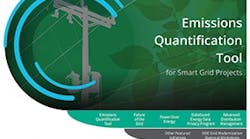Reduce Your Carbon Footprint with New Tools
Trying to justify the investment in energy efficiency measures or renewables? Two new tools can help you determine the value of upgrades and retrofits that reduce your power consumption and greenhouse gas emissions.
Emissions Quantification Tool
A free web-based tool by the DOE delivers hard numbers on the changes to carbon dioxide, sulfur dioxide and nitrogen oxide emissions you can expect from reducing power usage, as well as estimates of energy and financial savings. The technologies evaluated in the tool include coordinated electric vehicle charging schedules, battery storage for energy and grid-integrated solar generation.
“Users can quickly and easily screen different scenarios by varying the type of smart grid technology and other variables to best characterize their circumstances and location,” explains Karen Studarus, Power Systems Engineer at the DOE’s Pacific Northwest National Laboratory (PNNL), which developed the tool. “The modules we’ve assembled are being used right now to explore the impacts of proposed projects and understand the sometimes counterintuitive tradeoffs.”
The web-based Emissions Quantification Tool produces a detailed report with pre- and post-adoption comparisons for each technology, along with details on variables that can affect the investment’s value, such as how much energy storage the user would need to provide a certain level of operational benefits and what the resulting increase or decrease in emissions would be. Its calculations are based on established data sources like the EPA’s AVERT (Avoided Emissions and Generation Tool), which maps the hourly emissions benefits of energy efficiency and renewable energy programs. Investigate the Emissions Quantification Tool at smartgrid.gov.
IFMA’s Carbon Footprint Guide
The latest volume of IFMA’s Sustainability How-To Guide series focuses on how FMs can reduce an organization’s carbon footprint. Authors Sharon Jaye and Trevor Anderson walk facilities professionals through the greenhouse gas inventory process, a critical management tool for carbon footprinting, and then demonstrate how to establish trend-tracking baselines, develop mitigation strategies and assess progress.
“Sustainability is no longer just a value-based question. It is a core strategic imperative for any company that intends to thrive and grow in the years ahead,” Jaye and Anderson note. “Reporting on carbon footprint performance is one important way for organizations to manage their impact on sustainable development.”
Using the guide, facilities managers learn how to:
- Learn metrics, boundaries and collection instructions for a greenhouse gas inventory
- Benchmark and report emissions
- Set goals for emissions reduction and chart progress toward that goal
- Make the business case for emissions reduction investments, including cost savings from operational efficiencies, increased revenues and new markets, and intangible benefits such as competitive positioning and better shareholder relations
The carbon footprint guide is one of 17 in the Sustainability How-To Guide series. Check it out at community.ifma.org/knowledge_library.


